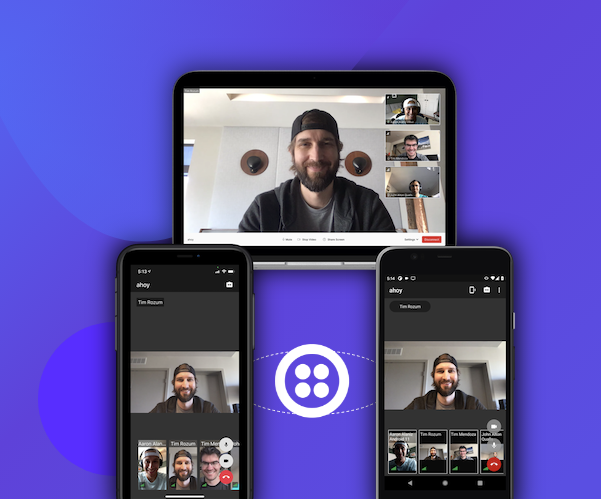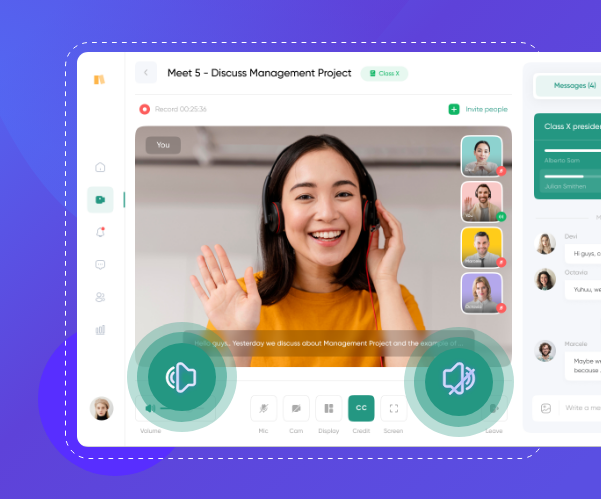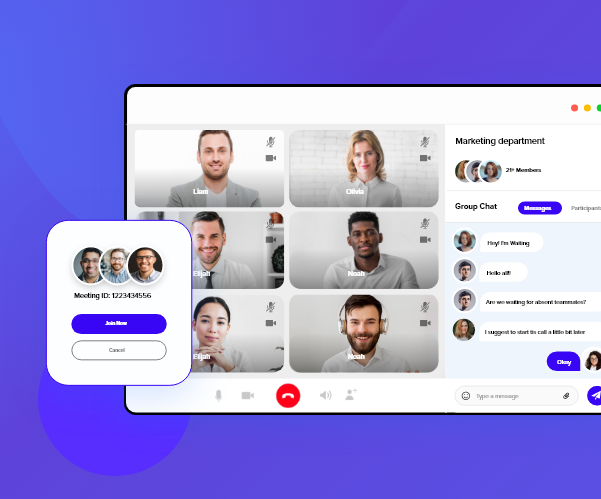In recent times, APIs and SDKs have gained a lot of demand and are considered as a trending technology. This is because of the COVID situation, which has made room for remote work and hybrid settings. Currently, business communication needs live video call apps, as by each day a greater number of people are getting into distant work environments. The demand has pushed developers to explore and adapt quick and easier options.
Developers are making use of top APIs and SDKs to build these live video call apps and stay competitive in the market. The features offered by these APIs and SDKs are not only advantageous but also make it simple and swift for developers to build live video call apps.
Because of which, developers need to be cautious about choosing the best video call API and SDK providers to build their video call app.
Table of Contents
How to Build a Highly Scalable 1-to-1 Video Calling App?
Before developers start building a live video calling app, they must know whether they would be using a video chat API or creating one on one video chat app from scratch. Whichever path they may choose, the agenda should be to scale the app eventually so that there are possibilities of expansion. Generally using paid or free video call API for websites and apps is considered the best way to build a live video calling app as it offers growth prospects.
Nevertheless, here are some of the amazing features offered by top video APIs and SDKs, and are considered to be the best way to scale an app.
15+ Ultimate Features in Live Video Calling App [2024]
1. Secure Call Recording

This is an essential feature that developers want to incorporate when building a live video call app because it allows them to record calls without any other individuals on them knowing about it in advance. It’s also ideal for recording meetings for training purposes and background checks.
2. Video Face to Face Call Recording

This option is also available with WebRTC technology that allows developers to record video of their face, which is ideal for showing them what they’re doing or caught on camera in action and provides proof of the call. About WebRTC API: In 2016, the Open Day event will be held in Seoul, Korea, bringing together experts from different fields and sharing their knowledge on WebRTC API. More than 200 people from the industry attended, including the founder and CEO of Korea’s WebRTC platform, ICTP. This year’s conference will be held in October, Seoul Korea.
3. Animation

Developers can utilize GSAP for their animations using HTML5 and CSS3 and JavaScript. This makes it easy for developers to produce animations that make the call interactive or have some intelligence. GSAP is specifically for animation and can control, scale, and add effects. In addition, GSAP’s animations do not require additional libraries apart from standard HTML5 support.
3. Active Talker

An active talker is a video call app feature used to determine who the active speaker is on the call. It assists with the conversation and makes it easier to understand where each person is on the call. This can be implemented by using VideoJS and Kurento, which are two APIs that work together that help developers track active speakers and mute or unmute other individuals on a video call.
5. Breakout Rooms

The developer uses a breakout room API to allow users to break off into smaller video conference rooms. This is convenient in a large video call or meeting as it allows for discussion about certain topics without disrupting the rest of the team. The breakout room can be used for any reason and is a great tool for collaboration and business meetings.
6. Control Room

When using an API like XMPP, developers can create chat rooms dedicated to controlling the video call. This API works with WebRTC and helps track active speakers on the call while also allowing people in charge of running things to talk directly with everyone else involved on that call.
7. Dashboard and Insights

When using a video call API, developers can create dashboards that show statistics and analytics of the call. This allows for data to be analyzed and analyzed continuously to keep track of various aspects, such as responses and length of calls. Insights can also be added that allow for insights on who’s responding to whom, which is useful when building a live video call in real-time.
8. Enhanced Security

When building a live video call app with one of the protocols such as Nova, developers can add enhanced security features, such as authentication and encryption. Nova is a real-time communication API created by video calling experts and launched in 2017. It’s used with other developers and has enhanced security features based on WebRTC technology.
9. Global Media Zones

Global media zones are made possible with the help of a protocol like Twilio. This is great for customer relations and events, and enterprise building. With the Twilio Video API, developers can create custom dashboards personalized and branded to their audience or company.
10. JavaScript SDKs

Developers who use JavaScript can integrate it into our live video call apps by utilizing a JavaScript SDK like JXcore. This is a full-featured library that is asynchronous and server-driven, making it faster than NodeJS in some aspects, such as memory management.
11. Individual Stream Pinning

This feature can be used when building a live video call app with WebRTC. Here, you’re able to have one video stream pinned while still using the other camera to capture other individuals or show other things. This is also known as “individual stream pinning”.
Also Read: WebRTC FAQs (Frequently Asked Questions)
12. Mute and Unmute

This is an essential feature to have when building a live video call app. It allows you to mute other users on the call when they are not talking or speaking inappropriately, such as swearing or saying inappropriate things. It also gives other people the ability to unmute when they want to talk or chime in on a conversation.
13. Live Streaming

Developers can utilize an API like Twilio Streaming when developing a live video call app. This API allows developers to create live streaming calls by distributing the calls over time. It also has a quota system and helps with image compression, which allows for lower bandwidth usage.
14. Moderated Entry

This is a feature available with some of the SDKs, such as Twilio Video. For instance, developers can add a moderator to an in-progress call if someone tries to join and cannot be approved. The moderator can then approve or deny that individual without disrupting the other participants on the call.
15. Screenshare and Annotation

A feature of WebRTC calls is the ability to share your computer’s screen on a video call. This allows for a live collaboration session to see what the other person is doing and sharing at any given time, like showing them a website or demonstrating something in real-time. This also enables you to scribble, draw, or annotate anything that appears on the screen, which is helpful for teacher-student learning.
16. SIP Interconnection

This allows for the communication of SIP-connected apps within a video call. This is possible with the help of an API like Kurento, which is used to help create SIP interconnections on WebRTC calls. It works with open-source components such as XMPP and Jingle and helps enable real-time communication between WebRTC clients.
17. Smart Network Optimization

Smart network optimization is available with some of the video call APIs. This feature can be added to help reduce latency and packet loss on WebRTC calls. It works by monitoring conditions in real-time and changing settings to help improve quality when it detects a poor connection or one that’s degrading quickly.
18. Waiting Lobby

A waiting lobby is a feature of WebRTC services that adds a custom waiting room to any live video call app. This can be helpful if you want to call multiple users or set certain conditions before starting a video call.
19. WebRTC

WebRTC is the underlying protocol used with most video calling APIs out there. It stands for “Web Real-Time Communication”. It uses JavaScript APIs, making it possible for developers to create applications that can make calls without installing any additional software or plugins on their computers or mobile devices.
Also Read: What is the Flutter WebRTC Plugin? A Complete Guide
How Are Video Calling APIs Used in Various Industries?
Video calling APIs are used in multiple industries with an agenda to improve productivity and connectivity. An audio video calling software can be integrated in any type of industry to enhance communication. The use of mobile phones has surged at a rapid pace and the industries are stepping into the digital world – making Video calling APIs one of the highlights of today’s business communication.
1. Video Calling API in Customer Engagement
It also has many features that improve customer engagement. For example, the API can be used to create chat messaging applications and whitelabel chat solution dashboards that are branded for the company’s customers. As a result, it’s a helpful addition to any live chat app.
2. Video Calling API in Security
The API can monitor calls in real-time and alert security teams if something goes wrong, like if there is yelling or someone starts using curse words, which helps prevent targeted attacks like swatting or other keyed assassinations via live video call apps.
3. Video-Enabled KYC
Video-enabled KYC is a feature that has been used in the finance industry to help authenticate individuals. This is when a customer makes a video call with an agent, and the agent can see them and take their picture, which then goes through facial recognition software to verify their identity.
Recommended Reading: Conversational Banking | How To Build A Fintech App?
4. Streaming and Broadcasting
The video call API can also be used for broadcasting when you want to broadcast live events on a video call platform. It’s also helpful for streaming when someone wants to stream their content and send it over a live video call. Streaming and broadcasting are also essential features of many live video call apps.
5. Group Collaboration
The video call API can also be used for group collaboration. With the help of a live video call platform, companies can use it to host meetings and conferences and collaborate on documents. Groups can also share their screen with others on a video call and compare what they see from their perspective.
How MirrorFly can help you to Build your Own Video Chat App?
Still not sure on how to build a video chat app?
Speak to an expert from MirrorFly – A #1 Provider Of SaaS & Self-hosted Video Calling SDKs!
In short, MirrorFly is the industry-best in-app chat SDK provider that offers both Saas & self-hosted video chat solutions to build a highly scalable and secure video calling capabilities across web and mobile apps. To know more about its features and pricing, check this link out.
Looking To Build Your Own Video Chat App?
Get our enterprise-grade communication solution, that can be set up on your company servers.
Request Demo100% customizable
White-label solution
Full source code

Further Articles








Leave a Reply